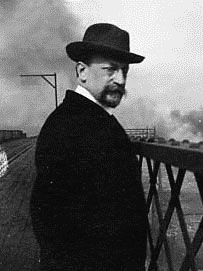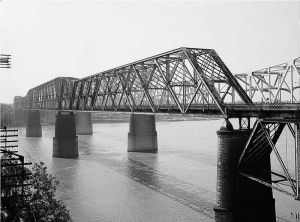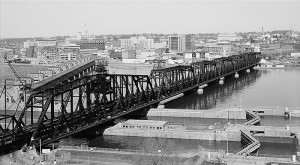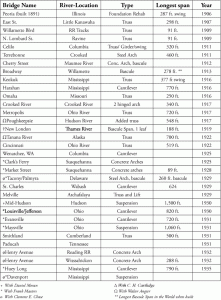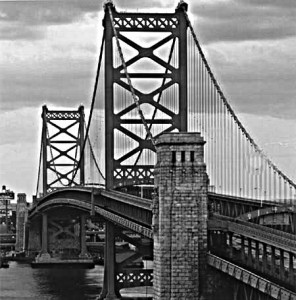Modjeski, (ne. Rudolphe Modrzejewska) was born in Cracow, Poland on January 27, 1861. His mother was an internationally known actress who encouraged him to become a concert pianist. But, at an early age, he determined he would become a civil engineer. His family came to the United States to attend the Centennial Celebration in Philadelphia and start an orange farm near Anaheim, California. His mother continued her acting career and Modjeski attended schools in the San Francisco area for a short time. In 1878, Ralph went to France to prepare for study at the École des Ponts et Chaussés, one of the leading schools of Civil Engineering in Europe. After failing admission on his first attempt, he was accepted and graduated in 1885 at the top of his class. Shortly after, he returned to the United States.
Modjeski obtained a position with George S. Morison, a leading bridge engineer of the time (STRUCTURE February 2008) building a bridge over the Missouri River at Omaha, Nebraska. He completed his bridge training by inspecting the rolled steel at the mill. He worked in the fabricating shop and then in the drafting room preparing shop drawings and plans. He worked with Morison on his Willamette, Nebraska City, Sioux City, Winona, and Cairo bridges. His last design project with Morison was the Memphis Bridge across the Mississippi River, which was the longest span cantilever in the country at the time. He also supervised construction of the bridge between 1891 and 1892.
Modjeski built his first bascule bridge across the Chicago River with Joseph B. Strauss as his assistant. He then went into partnership for a short time with J. F. Nickerson, followed by his becoming Chief Engineer on a Bridge across the Mississippi River at Rock Island. It was the fourth bridge at this site and was a seven span railroad and roadway bridge with a swing span over a set of locks.
In 1902, Modjeski went into partnership with Alfred Noble forming the firm of Noble and Modjeski with one of their largest projects being a cantilever across the Mississippi at Thebes, Illinois. After this bridge was finished, Ralph designed many bridges in the Portland, Oregon area (see Table). He replaced George Morison’s bridge across the Missouri River in Bismarck, North Dakota in 1905 with 400-foot spans, followed by a pair of swing bridges across the Columbia and Willamette Rivers in Portland, Oregon in 1908-1910. The Willamette swing bridge had a length of 521 feet, making it the longest span bridge at the time. In August 1908, he was appointed to a Board of Engineers, not a full time position, to determine the type of bridge to be built in replacement of the 1907 failed Quebec Bridge by Theodore Cooper and the Phoenix Bridge Company. Modjeski, along with H. E. Vautelet and Maurice Fitzmaurice, were instructed to receive new tenders with the bridge companies submitting their design. Vautelet also prepared his own design which Fitzmaurice and Modjeski did not approve of. Fitzmaurice left the board and was replaced with Charles Macdonald (STRUCTURE, January 2009) formerly of the Delaware and Union Bridge Companies. After reviewing the 1910 proposals, Vautelet, Macdonald and Modjeski could not agree on a specific recommendation, as Vautelet recommended one of the tenders on his own design and Macdonald and Modjeski recommended a design by the St. Lawrence Bridge Company. Vautelet left the Board and was replaced by Lt. Col. Charles Monsarrat and Macdonald was replaced by C. C. Schnieder (STRUCTURE, January 2011). It was these three engineers who oversaw the existing Quebec Bridge, then the longest span bridge in the world, that opened in September 1917. Throughout this assignment Modjeski continued to serve as consulting engineer to other clients.
Other bridges followed in 1910 with the McKinley Bridge across the Mississippi River at St. Louis, a long span of 519 feet. A partial list of other bridges by Modjeski is shown in the Table.
Ralph went into partnership with Walter Angier, under the name Modjeski and Angier, between 1912 and 1924 with several offices around the United States. Angiers worked with him since 1902 on the Thebes Bridge, and their eventual splitting evidently was not on good terms. He later partnered, in 1924, with Frank Masters, who had worked with him and Angiers between 1904 and 1914 on the Memphis and Louisville Bridges. Later Modjeski brought Clement E. Chase, who had worked under him on the Ben Franklin Suspension Bridge across the Delaware river at Philadelphia, into the partnership under the name of Modjeski, Masters and Chase. Montgomery Case came into the firm in 1933 when Chase died after a 120 foot fall from the Delaware Bridge. Modjeski mentored all these men and Joseph Strauss, just as he had been mentored by Morison and Noble.
As early as 1920, Modjeski was involved in planning for a bridge across the Delaware River at Philadelphia. In 1921, he was appointed Chief Engineer with Leon Moiseff as Engineer of design. The bridge was completed in 1926. With its 1,750-foot span, it was the longest suspension bridge in the world at the time. He broke this record in 1929 with the opening of the Ambassador Bridge over the Detroit River, which then became the longest span suspension bridge in the world with a span of 1,850 feet.
One of his later projects was as President of the Board of Consultants for the San Francisco Oakland Bay Bridge. The design consisted of a long deck truss eastern approach followed by a major cantilever bridge followed in turn by a tunnel through the Yerba Buena Island and then by a double suspension bridge with a common middle anchorage. It was being built at the same time as the nearby Golden Gate Bridge, but opened six months earlier on November 12, 1936.
His biographer, W. F. Durand, wrote, “In personal character Mr. Modjeski was inclined to be reserved rather than expansive and did not readily make close friendships. Nevertheless, he did take a generous and deep interest in his associates and in the members of the engineering profession broadly.”
An intimate personal friend of long standing, Ralph Budd, wrote to “understand him it must be appreciated that he inherited the temperament of an artist – not the artistic bias which is sometimes urged as the excuse for irrational behavior, but the delicate intuitive perception which insures balanced good taste and harmony in its outward expression, whether in music, art, architecture or engineering structures. In his professional work Mr. Modjeski always insisted on simplicity of treatment, with emphasis on function and purpose.” When he was awarded the John Fritz Medal by ASCE, Jay Kip Finch wrote, “Mr. Modjeski’s engineering designs are characterized by sincerity, which is the basis of true art. The gracefully sweeping lines of the Delaware Bridge, the Gothic treatment of the Poughkeepsie Suspension Bridge towers demonstrate the beauty which is inherent in steel construction, when freed from attempts at embellishment or concealment by means of masonry and concrete. His work will serve to lead others away from ill-considered attempts to adapt architectural tradition blindly to the treatment of steel structures without recognizing the fundamental artistic values arising from straightforward expression of the action of forces and the manner of their resistance.”
Finally, it was said of Modjeski that he had “to his credit more large bridges than any other man.” The New York Times in his obituary on June 28, 1940 hailed him as “the world’s leading bridge builder.” While that may not have been absolutely true, he was surely one of the world’s leading bridge builders over an extended period of time. He built the longest swing span, the longest suspension bridge (twice), the longest cantilever bridge and many early reinforced concrete bridges and long span simple trusses.▪

